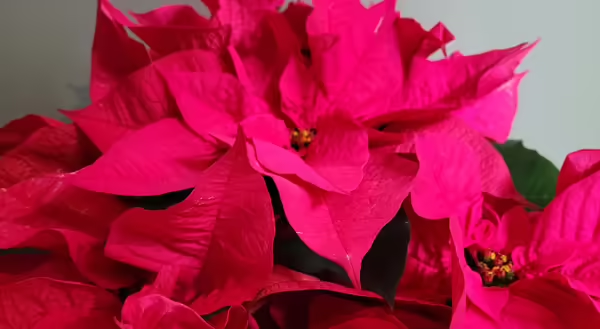
The colorful poinsettia is a beautiful addition to end-of-the-year holiday festivities. One of the most common questions about poinsettias is how to keep them and get them to rebloom the following season.
The first step to reblooming is to keep the plant healthy and growing throughout the year. Around the first of the year, fertilize your poinsettia with a soluble houseplant fertilizer. Six hours of indirect light and consistently moist soils will keep the plants healthy.
In mid-February, near Valentine’s Day, inspect the plant and manage any insects you find. Whiteflies can be a common problem. If your plant is becoming leggy, cut the stems back to about 5 to 6 inches tall, making sure some leaves remain. This pruning will give a more compact plant.
Remove dried and faded leaves and stems as we move into March and come to St. Patrick’s Day. Leave the plant in a bright, sunny spot and monitor the soil, maintaining consistently moist, well-drained soil. Check the soil level. Add sterile soilless mix if necessary.
Once the danger of frost is past and temperatures are above 50°F, move the plants outdoors—place them in indirect light. May, prune back branch tips to promote side branching. To do this, prune above an outward-facing node. This is an excellent time to repot into a slightly larger container in a sterile growing mix.
After the plant has acclimated to the outdoors, you can move it to a sunny location with a bit of afternoon shade. Mid-summer care includes more trimming back, fertilizing, and watering.
When nighttime temperatures start getting down to 40°F, it is time to move the plants back indoors.
The plants still need 6 hours of light every day. Reduce the fertilizer to one-quarter of its regular rate.
In the middle of September to October, find a place for the plant to get at least 14 hours of uninterrupted darkness and 8 to 10 hours of bright light. Even a short exposure to light from the television or car headlights can cause disrupt the flowering process.
Keep the night temperatures in the low 60°F range. Continue to monitor soil moisture.
Be sure to rotate the plant to expose the whole plant to even light.
After about two months of the long night/ short day lighting treatment, the bracts will turn colors. At this time, near Thanksgiving, discontinue the light treatment and place the plant in a sunny window with 6 hours of direct light daily.
As the Holidays approach, enjoy your poinsettia blooms. You can look forward to starting the cycle again after the new year.
Although there is no guarantee that your poinsettia will bloom again, you can enjoy the process of caring for your plant throughout the year. With these tips, proper care, and patience, your plants will look beautiful for the next holiday season.
MEET THE AUTHOR
Nicole Flowers-Kimmerle is a Agriculture and Natural Resources (Horticulture) Educator for Fulton, Mason, Peoria and Tazewell counties. She completed a bachelors of science degree in crop science at the University of Illinois, and a master’s of science degree in agronomy with an emphasis in weed science at the University of Wisconsin-Madison. She has also worked at Montana State University as a research associate where she worked on weed control in sugar beets and barley. She taught high school chemistry and other science classes where she was able to teach students in both the school garden and greenhouse. She works with both the Extension Master Gardeners and Extension Master Naturalists.
ABOUT THE BLOG
ILRiverHort is a blog that helps people connect to nature and grow.